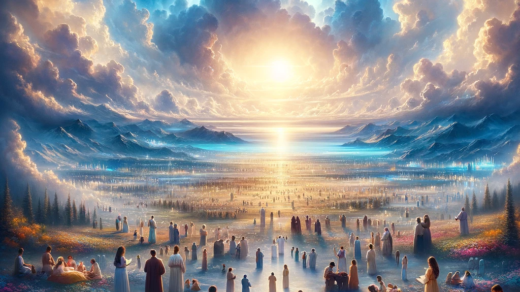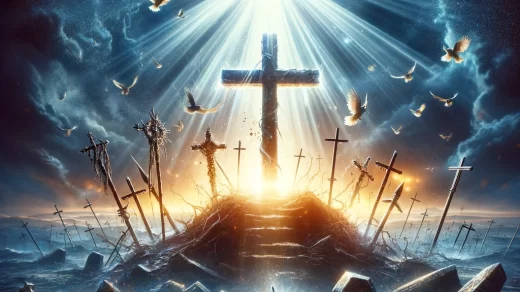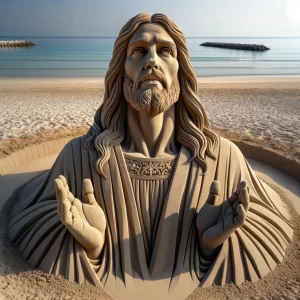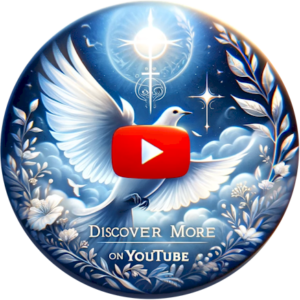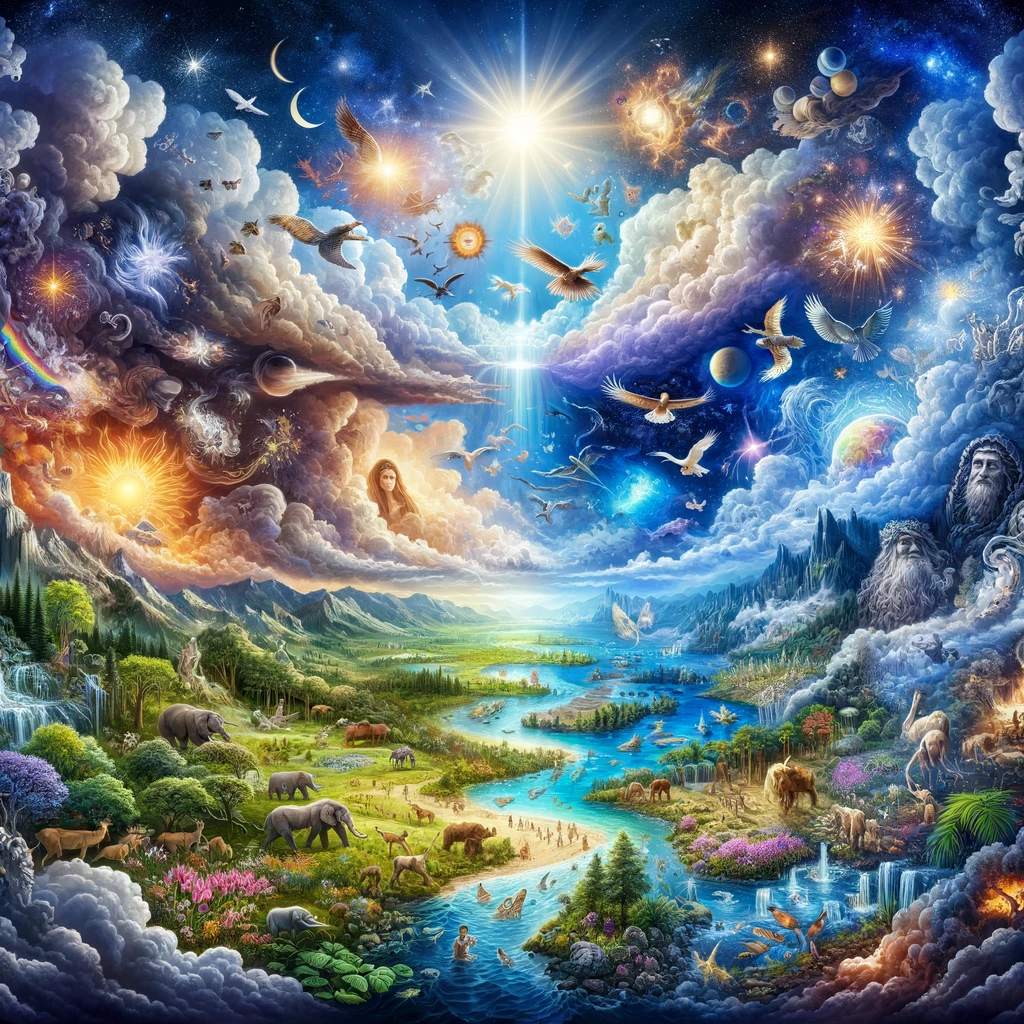
The creation story in the Bible is a foundational narrative for many believers, detailing how God created the world and everything in it. This story is primarily found in the first two chapters of Genesis, the first book of the Bible. It describes a sequence of events across six days, leading to the creation of the Sabbath on the seventh day, a day of rest. Here’s a brief overview of the creation story as outlined in Genesis 1 and 2:
Day 1: Light and Darkness
- Genesis 1:1-5
God begins the creation of the world out of a formless void. He says, “Let there be light,” and light is created, separating light from darkness.
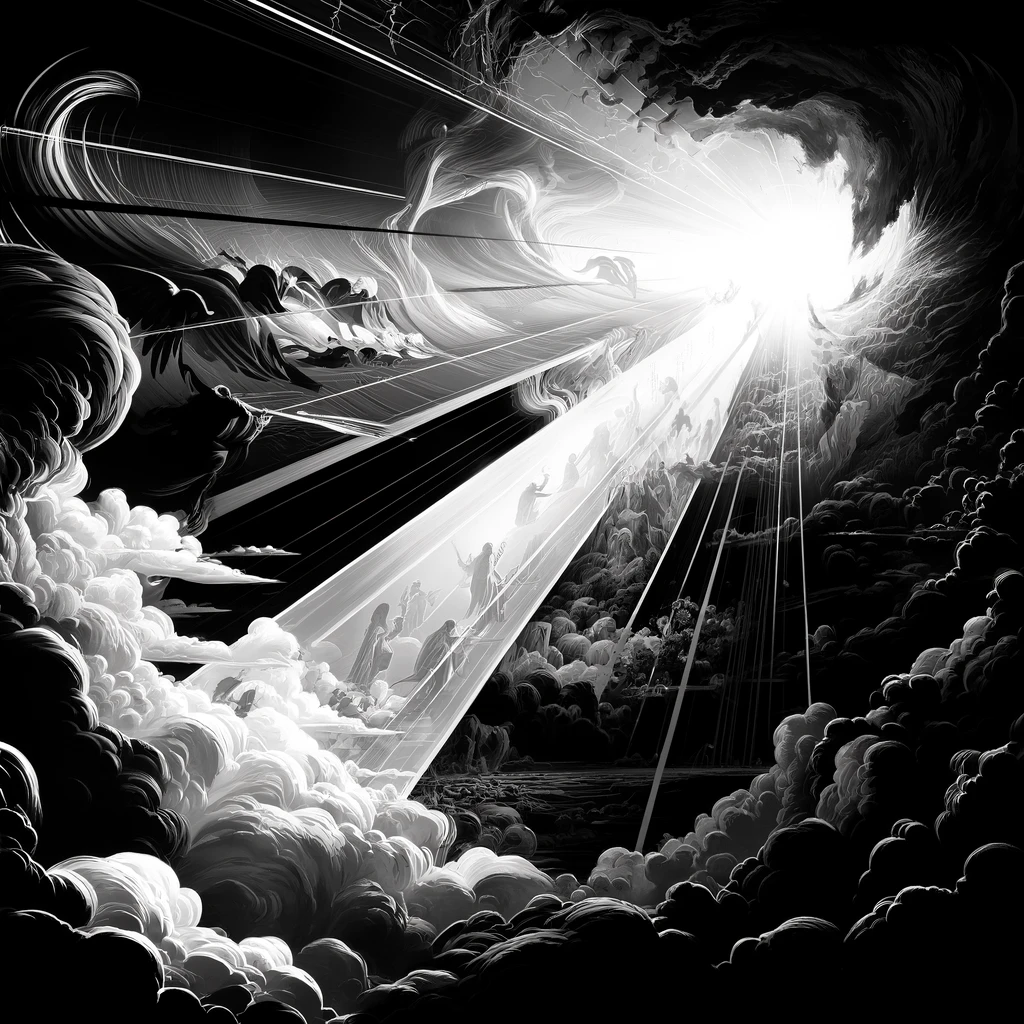 The Beginning of Creation: Light and Darkness
The Beginning of Creation: Light and Darkness
The opening verses of the Bible introduce us to the beginning of time and the start of God’s creation. “In the beginning, God created the heavens and the earth.” This statement sets the stage for everything that follows in the Bible, affirming God as the sovereign creator of all. The earth, at this point, is described as “formless and empty,” with darkness covering the “deep waters.” This imagery evokes a sense of a blank canvas, awaiting the touch of the divine artist.
The Command for Light
God’s first recorded act of creation is to bring light into existence. “Let there be light,” He declares, and instantly, light is. This act is profound for several reasons. Firstly, it demonstrates God’s absolute power and authority—His words alone are sufficient to bring about creation. Secondly, the creation of light signifies the dispelling of chaos and darkness. Light, in the Bible, often symbolizes goodness, truth, and the presence of God Himself. By initiating creation with light, God is establishing order, marking the dawn of time, and laying the foundation for life.
Separation of Light and Darkness
After creating light, God “saw that the light was good,” indicating His approval and the inherent goodness of His creation. He then separates the light from the darkness. This separation is significant as it introduces the concept of division or distinction in creation—between day and night, which are fundamental to the ordering of time. God names the light “day” and the darkness “night.” This act of naming demonstrates God’s sovereignty over creation, as naming something signifies authority over it.
The First Day
The passage concludes with the marking of this period as the first day: “And there was evening, and there was morning—the first day.” This introduces the biblical concept of a day, starting with evening and ending with morning, which is a reflection of the Jewish understanding of the daily cycle.
Theological Significance
This initial act of creation has deep theological implications. It reflects God’s power to bring light and order out of chaos and darkness. The creation of light before anything else underscores its importance and preeminence in God’s creation. Light is foundational to life and is a prerequisite for the rest of the creative acts that follow. Additionally, the separation of light from darkness foreshadows the theme of separation between good and evil, a motif that runs throughout the Bible.
This passage, while brief, invites reflection on the nature of God as Creator, the inherent goodness of creation, and the ordering principle that governs the universe. It sets the stage for the rest of the creation narrative, highlighting the meticulous care and intentionality behind the universe’s design.
Day 2: Sky and Waters
- Genesis 1:6-8
God creates an expanse (sky) to separate the waters above from the waters below.
On Day 2 of the Creation story, as recounted in Genesis 1:6-8, God continues the divine act of bringing order and structure to the universe. This day focuses on the creation of the sky, or what’s termed as the “firmament” in some translations, which serves to divide the waters.
 The Formation of the Sky
The Formation of the Sky
The command “Let there be an expanse between the waters to separate water from water” introduces the concept of division or separation as a divine principle in creation. God is not just creating; He is also organizing the created world into a harmonious system. The “expanse” created by God is what we understand as the sky, the atmosphere that envelops the earth. This atmospheric vault serves a critical function: it divides the waters on the earth from the waters above it, possibly referring to the clouds or the water vapor in the sky. This division is essential for creating a habitable environment on Earth.
The Naming of the Sky
God names this expanse “sky.” Just as with the naming of day and night, this act of naming underscores God’s sovereignty and authority over creation. The sky is an integral part of the created world, serving as a canopy over the earth. It is the realm where birds will later fly and where the clouds gather, a boundary between the earth and the heavens above.
The Separation of Waters
The separation of the waters is a fascinating aspect of this day of creation. By establishing a division between the waters above and the waters below, God prepares the earth for the emergence of life. This separation is crucial for the development of a stable environment, including the water cycle that sustains terrestrial life. Rain, clouds, and the atmosphere itself become key components of the earth’s ecosystem, all originating from this divine act of separation.
Theological and Symbolic Implications
This act of creation has profound theological and symbolic implications. The sky or firmament represents God’s provision and care for all creation, ensuring the earth is a place where life can flourish. The separation of waters also symbolizes the order and boundaries that are inherent in God’s creation, contrasting the initial state of formlessness and void.
Furthermore, the sky serves as a canvas for the rest of creation, where God will later set the sun, moon, and stars to govern time and seasons. It becomes a visible reminder of God’s presence and power, often associated with divine revelations and signs.
Takeaway
Day 2 of the creation story emphasizes God’s intentional structuring of the universe. The creation of the sky and the separation of the waters demonstrate God’s desire for order, sustainability, and beauty in the world. This narrative invites reflection on the complexity and interconnectivity of creation, showcasing the sky not just as a physical reality but as a testament to divine wisdom and foresight.
Day 3: Land, Seas, and Vegetation
- Genesis 1:9-13
God gathers the waters below the sky into one place, revealing dry ground (land) and calls the gathered waters seas. On this land, He creates vegetation: plants and trees that bear fruit.
Day 3 of the creation story in Genesis 1:9-13 brings about the emergence of dry land, seas, and vegetation, marking a significant phase in the formation of a habitable earth. This day focuses on the establishment of the terrestrial environment and the provision of food through plant life. Here’s a deeper look into the events of this day:
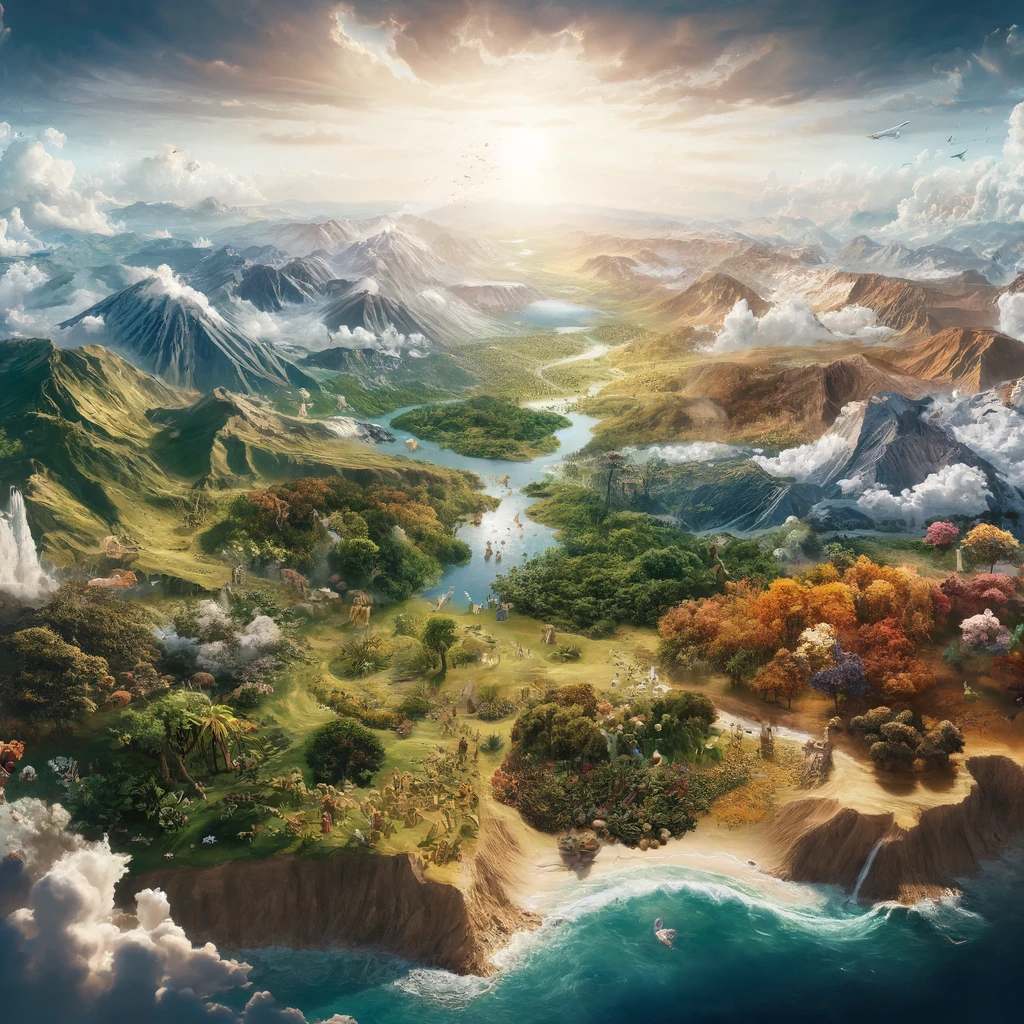 The Gathering of Waters and the Appearance of Land
The Gathering of Waters and the Appearance of Land
The command “Let the water under the sky be gathered to one place, and let dry ground appear” leads to the formation of land masses and the gathering of waters, which are called “seas.” This separation creates a distinct environment for terrestrial life and further establishes the physical structure of the earth. The appearance of dry land is crucial for the next phase of creation—the emergence of plant life. By calling the dry ground “land” and the gathered waters “seas,” God continues the theme of order and organization within creation.
The Creation of Vegetation
Once the land appears, God commands the earth to produce vegetation: plants bearing seeds and trees bearing fruits with seeds in them. This command results in the earth bringing forth a variety of plants and trees, each according to its kind. This vegetation is not only for the beauty and balance of the natural world but also serves a practical purpose—providing food for the earth’s future inhabitants. The specification that plants and trees should bear seeds ensures the sustainability and continuity of plant life, establishing a self-replicating system of nourishment and growth.
The Blessing of Fertility and Abundance
The ability of plants and trees to reproduce “according to their kinds” introduces the concept of biodiversity and ecological balance. This diversity reflects the creativity and wisdom of God in designing a world rich in resources and beauty. The phrase “according to their kinds” emphasizes the orderliness of creation, with each plant and tree designed to fulfill a specific role within the ecosystem.
Theological and Symbolic Significance
This day of creation has deep theological implications, illustrating God’s power not only to create but to sustain life. The provision of food through plants and trees even before the creation of animals and humans shows God’s foresight and care for all living creatures. The emergence of dry land and vegetation also symbolizes the transformation from chaos to order, from barrenness to fruitfulness.
Moreover, the act of God blessing the earth to bring forth vegetation suggests a partnership between the Creator and the creation. The earth responds to God’s command, actively participating in the act of creation. This dynamic indicates a relationship between God and the world He creates, characterized by responsiveness and reciprocity.
Takeaway
Day 3 of the creation narrative underscores the themes of provision, abundance, and preparation. By separating the land from the seas and clothing the earth in greenery, God prepares the stage for the abundance of life to come. This day reflects the divine intentionality in creating a world that is not only habitable but also capable of sustaining and enriching life. The creation of land and vegetation is a testament to God’s wisdom and care, setting the foundation for the complex web of life that will populate the earth.
Day 4: Sun, Moon, and Stars
- Genesis 1:14-19
God sets lights in the expanse of the sky to separate day from night, creating the sun, moon, and stars to mark seasons, days, and years.
Day 4 of the Creation story, as outlined in Genesis 1:14-19, focuses on the placement of lights in the expanse of the sky to serve distinct purposes: to separate day from night, to mark seasons, days, and years, and to provide light upon the earth. This day’s events further elaborate on the establishment of time and the regulation of life rhythms on Earth.
 The Creation of the Sun, Moon, and Stars
The Creation of the Sun, Moon, and Stars
God commands the existence of lights in the sky to illuminate the earth and to distinguish between the day and the night. This command results in the creation of two great lights—the greater light (the sun) to govern the day and the lesser light (the moon) to govern the night—along with the stars. These celestial bodies are not merely decorative but are functional, serving to mark the passage of time and to signify seasons, days, and years.
Purposes of the Celestial Bodies
Separation of Day and Night
The sun and the moon serve to clearly separate light from darkness, creating a reliable cycle of day and night. This distinction is crucial for the biological rhythms of all creatures and plants that will inhabit the earth.
Marking Time
The celestial bodies are established as markers for time—seasons, days, and years. This organization of time is essential for the ordering of life on earth, including the cycles of growth, reproduction, and rest for plants and animals. The predictable movements of the sun, moon, and stars provide a natural calendar for agricultural activities, religious observances, and navigation.
Providing Light
The sun provides light and warmth necessary for life, influencing weather patterns and climates across the globe. The moon, reflecting the sun’s light by night, also influences the earth in more subtle ways, including the tides. The stars offer navigation points and have guided travelers long before the advent of modern navigation tools.
Theological and Symbolic Significance
The creation of the sun, moon, and stars on the fourth day has deep theological implications, underscoring the theme of God’s sovereignty over the cosmos. Unlike many ancient cultures that worshiped celestial bodies as deities, the Genesis account positions them as creations of the one true God, serving His purposes. This demarcation challenges idolatrous practices and reiterates the monotheistic belief in God’s supreme authority over all creation.
Furthermore, the meticulous order and harmony in the movement of celestial bodies reflect the wisdom and care of the Creator. The regularity and predictability of these heavenly lights speak to a universe created with purpose and intentionality, designed to sustain and nurture life in a myriad of forms.
Takeaway
Day 4 of the creation narrative brings to completion the formation of the physical universe with the establishment of the celestial bodies. By creating the sun, moon, and stars, God provides not only the physical light necessary for life but also the means to measure time, thereby organizing the life rhythms on Earth. This day emphasizes the majesty and meticulousness of God’s creation, showcasing a universe finely tuned for life and reflective of His glory and power.
Day 5: Marine Life and Birds
- Genesis 1:20-23
God fills the waters with living creatures and the sky with birds, blessing them to be fruitful and multiply.
Day 5 of the Creation story, as depicted in Genesis 1:20-23, marks a significant transition from the creation of the environment (light, water, sky, land) to the filling of these environments with life. On this day, God turns His attention to the waters and the sky, infusing them with a diverse array of living creatures.
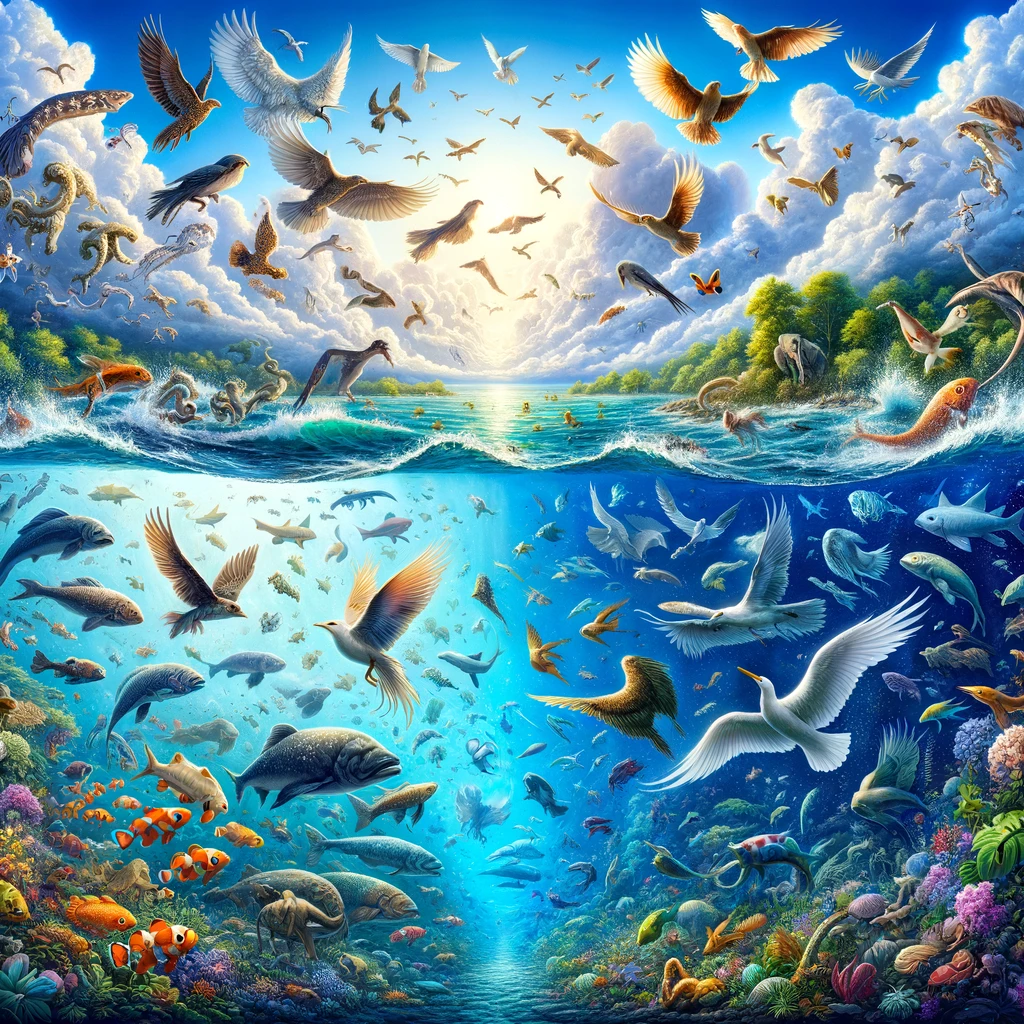 The Filling of the Waters
The Filling of the Waters
God commands the waters to “teem with living creatures,” and instantly, the seas become vibrant with fish and a multitude of marine life. This word “teem” conveys the idea of abundance and diversity, suggesting that the oceans were filled with life in all its forms, sizes, and colors. The creation of marine life on such a scale underscores the richness and generosity of God’s creative activity.
The Creation of Birds
Simultaneously, God creates every kind of bird to fly above the earth across the expanse of the sky. The skies, once empty, are now filled with the movement and melodies of birds. This not only adds beauty and dynamism to the world but also begins to establish the ecological balance and interdependence that will characterize the earth’s biosphere.
The Blessing of Fertility
A significant aspect of this day’s creation is the blessing God bestows upon these creatures: “Be fruitful and increase in number and fill the water in the seas, and let the birds increase on the earth.” This blessing is not merely a command to populate the earth but also an endowment of the inherent ability to reproduce and thrive. It marks the beginning of the natural processes of reproduction and growth that will ensure the sustainability of life on earth.
The Goodness of Creation
Once again, after creating the marine life and birds, God sees that it is good. This affirmation of the goodness of creation is a recurring theme in the Genesis account, reflecting the inherent value and beauty of the natural world as God intended it.
Takeaway
Day 5 of the creation narrative highlights the care and attention God invested in populating the earth with life. The creation of marine life and birds fills the earth’s environments with vitality and diversity, setting the stage for the more complex web of life that is to follow. This day teaches us about the abundance of God’s creativity, the value of biodiversity, and the importance of ecological balance. It reminds us of our responsibility to preserve and protect the natural world, which has been entrusted to our care. As we marvel at the variety and complexity of life that God has created, we are encouraged to recognize our place within this creation—not as owners, but as stewards of a world teeming with life.
Day 6: Land Animals and Humanity
- Genesis 1:24-31
God creates living creatures to inhabit the land—livestock, wild animals, and creatures that move along the ground. Then, God creates humanity in His own image, giving them dominion over the earth and its creatures. He blesses them to be fruitful and multiply.
Day 6 of the Creation narrative, as detailed in Genesis 1:24-31, brings to culmination the act of populating the earth with living creatures, including the creation of humanity, which is the climax of God’s creative work. This day is marked by two significant acts of creation: the creation of land animals and the creation of humans.
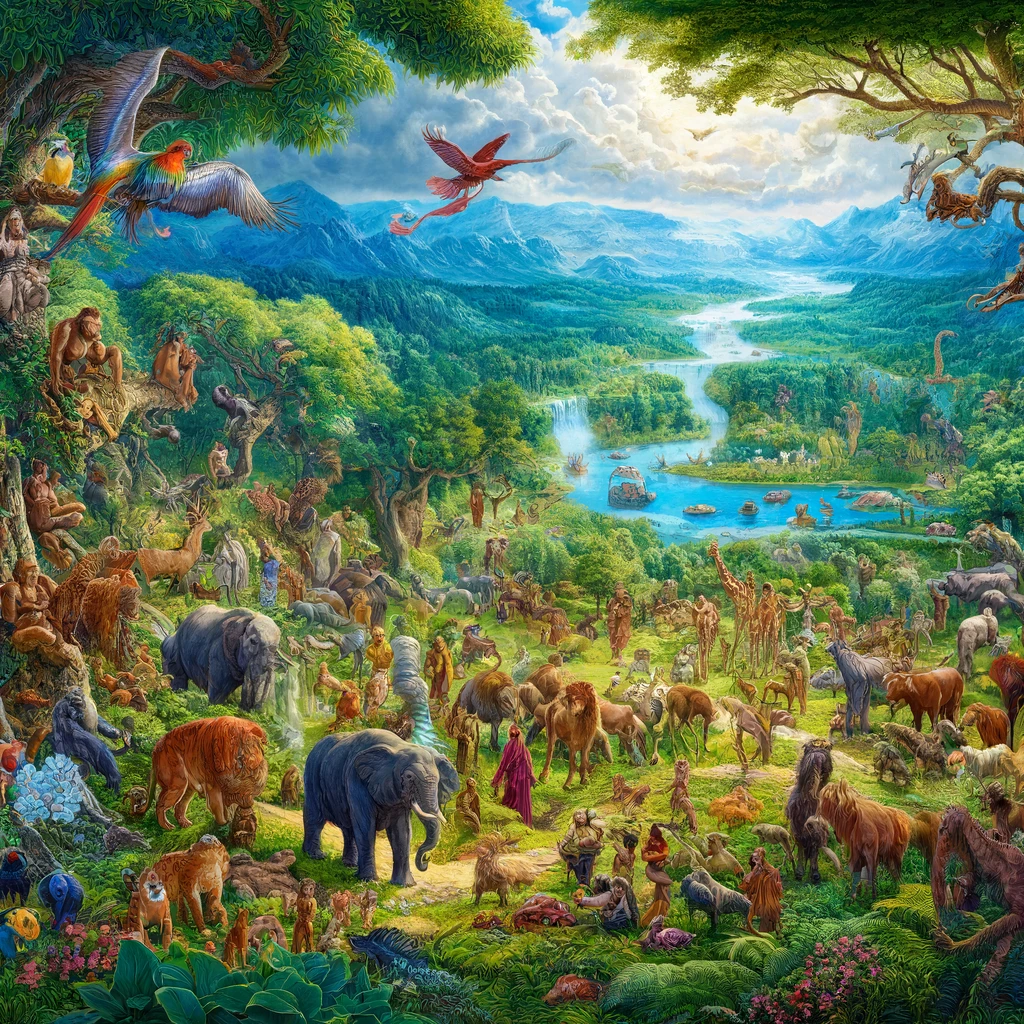 The Creation of Land Animals
The Creation of Land Animals
God begins Day 6 by commanding the earth to bring forth living creatures of various kinds: livestock, creatures that move along the ground, and wild animals. Each is created according to its kind, signifying the diversity within terrestrial life. This command further populates the earth with animals that inhabit different ecological niches, contributing to the balance and complexity of the biosphere. These creatures, like those created before them, are blessed by God and given the capacity to reproduce, ensuring the continuity of life on land.
The Creation of Humanity
The creation of humans is a distinct and deliberate act, highlighted by the divine council: “Let us make mankind in our image, in our likeness, so that they may rule over the fish in the sea and the birds in the sky, over the livestock and all the wild animals, and over all the creatures that move along the ground.” Humanity is thus created in the image of God, setting humans apart from the rest of creation. This imago Dei (image of God) bestows upon humans unique qualities, including the capacity for relationship with God, moral reasoning, creativity, and the responsibility to steward the earth.
Humans are blessed by God and given dominion over the earth and its creatures, a mandate that involves care, stewardship, and responsible governance of the planet’s resources. The creation of males and females reflects God’s intention for human community and partnership in fulfilling the earth’s stewardship.
The Provision for All Life
God also provides for the sustenance of all life by giving every green plant for food. This provision underscores the interdependence of all living things and God’s care in creating a world where the needs of every creature are met.
The Goodness of Creation
After the creation of humans, God surveys all that He has made and declares it “very good.” This pronouncement underscores the perfection and harmony of God’s creation before the fall of man. The world, in its original state, is a reflection of God’s glory and goodness.
Takeaway
Day 6 of the creation story reveals the intentionality behind God’s design, especially in the creation of humans with the unique role of bearing God’s image and stewarding creation. This day challenges us to reflect on our responsibility to care for the earth and its creatures, recognizing the inherent value and goodness in all that God has made. It calls us to live in a way that honors our role as stewards of the earth, promoting the flourishing of all life. The narrative invites us to see the world as God sees it: a creation teeming with life, diversity, and beauty, worthy of respect and care.
Day 7: The Sabbath of Rest
- Genesis 2:1-3
With the heavens and the earth completed, God rests on the seventh day, blessing it and making it holy because on it He rested from all the work of creating that He had done.
Day 7 of the Creation story, described in Genesis 2:1-3, marks a distinct transition from the act of creation to a state of rest and sanctification. Unlike the previous days where God actively shapes and populates the world, Day 7 is about cessation from work and the blessing of the Sabbath.
 The Completion of Creation
The Completion of Creation
The text begins by noting that the heavens and the earth were completed in all their vast array. This completion signifies that the work of creation was finished; the world was fully formed and filled with life. Everything needed for the earth to function and flourish had been set in place by God.
God’s Rest
On the seventh day, God rests from all the work of creating that He had done. This rest is not due to weariness but signifies completion and satisfaction in the work completed. God’s rest sets a divine precedent for the rhythm of work and rest in the human experience. It highlights the importance of rest after labor, not just for physical and mental rejuvenation but as a spiritual practice that acknowledges the sufficiency and completeness of God’s creation.
The Blessing and Sanctification of the Sabbath
God blesses the seventh day and makes it holy because on it He rested from all the work of creating that He had done. The blessing of the seventh day sets it apart from the other days, not in terms of the act of creation but in its sanctity and significance. The Sabbath becomes a day of rest and reflection for humanity, a day to acknowledge God’s sovereignty and to enjoy and reflect on His creation. It’s a concept that would later be woven deeply into the fabric of Jewish religious observance and, by extension, into Christian practice as a day of worship and rest.
Takeaway
Day 7 of the Creation narrative introduces the sacred practice of Sabbath rest, offering a model for humanity to follow. It teaches the value of pausing from our labors to reflect on the goodness of God’s creation, to rejuvenate, and to worship. This day underscores the importance of balance between work and rest, a principle that holds physical, emotional, and spiritual benefits. The sanctification of the Sabbath invites us to regularly step back from our routines and responsibilities to appreciate the world around us and to nurture our relationship with the Creator. It serves as a reminder of God’s lordship over time and creation, inviting us into a rhythm of life that reflects the divine order and priorities.
The Garden of Eden
- Genesis 2:4-25
A more detailed account of the creation of man and woman is provided, focusing on the Garden of Eden. It tells of how God formed man (Adam) from the dust of the ground, planted a garden in Eden for him, and from Adam’s rib made a woman (Eve) to be his companion.
The Garden of Eden holds a pivotal place in the Genesis creation narrative, introduced in Genesis 2:4-25. This segment of Scripture delves into the details of humanity’s first dwelling place, designed by God as a perfect habitat for the first man, Adam, and later, for the first woman, Eve. The Garden of Eden is more than just a location; it represents an ideal state of existence where humanity and God are in close relationship, and harmony pervades all of creation.
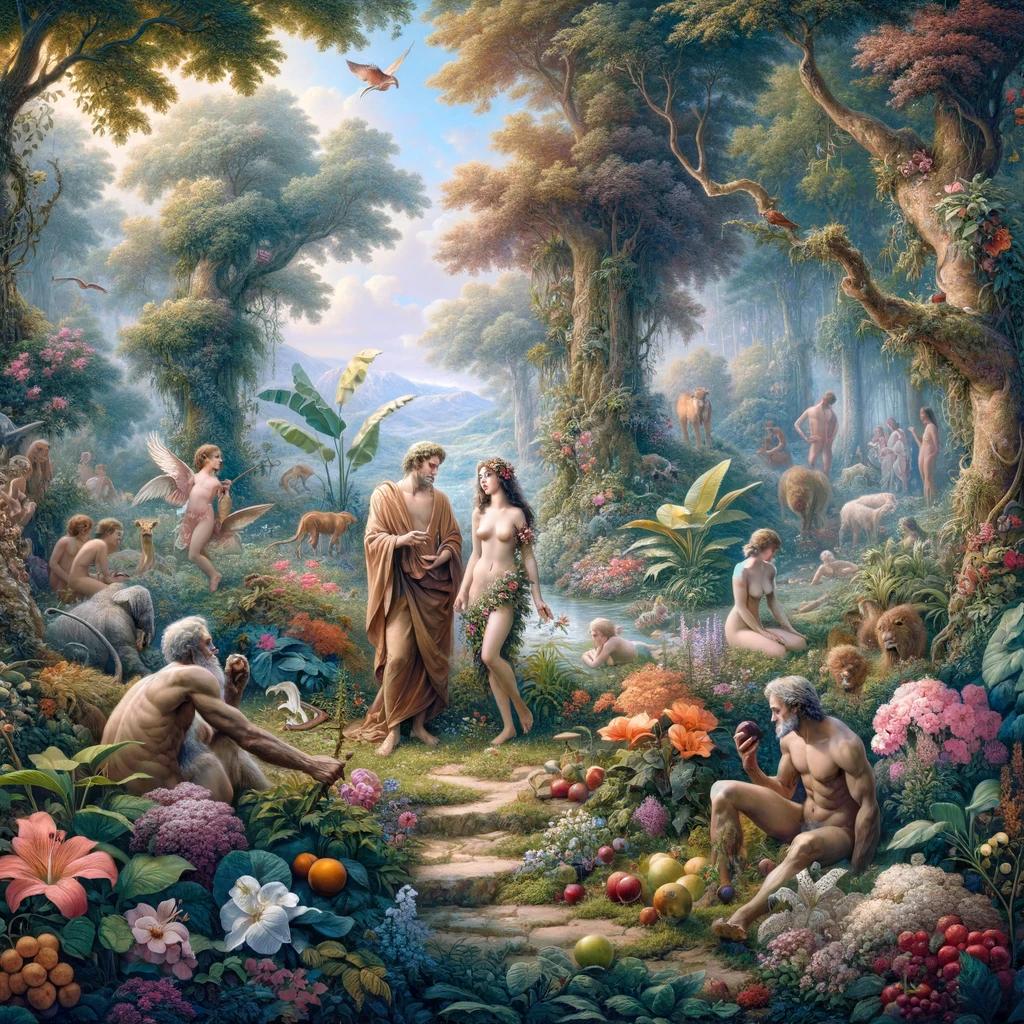 The Creation of the Garden
The Creation of the Garden
The Garden of Eden is described as a place of unmatched beauty and abundance, planted by God Himself. It was filled with a wide variety of trees that were pleasing to the eye and good for food. Among these were the tree of life and the tree of the knowledge of good and evil. A river flowed out of Eden to water the garden, and from there it divided into four headwaters, suggesting the garden’s location at the center of the world’s primordial geography and its importance as a source of life and sustenance.
The Inhabitant of the Garden
God placed Adam in the Garden of Eden to work it and take care of it, indicating humanity’s role as stewards of God’s creation. This stewardship was not burdensome labor but a fulfilling occupation in a perfect environment. Adam was given the freedom to eat from any tree in the garden except for the tree of the knowledge of good and evil, introducing the concept of free will and the importance of obedience to God’s commandments.
The Formation of Eve
Observing that it was not good for man to be alone, God decided to make a “helper suitable for him.” After none of the animals proved to be a fitting companion, God created Eve from one of Adam’s ribs, signifying her as an integral part of him. This act underscores the importance of human relationships and the complementary nature of men and women.
The Ideal Relationship
The Garden of Eden is the setting for the ideal relationship between God, humanity, and the rest of creation. It was a place where Adam and Eve walked with God, experiencing His presence directly. This direct fellowship with God represents the perfect state of innocence and purity before the fall.
The Significance of the Garden
The Garden of Eden symbolizes God’s intended harmony for creation, a place where peace, abundance, and the presence of God were everyday realities. Its narrative sets the stage for the themes of temptation, free will, sin, and redemption that play out in the rest of the Bible. Eden remains a powerful symbol of the lost paradise to which humanity longs to return, and it foreshadows the promised restoration through Jesus Christ.
Takeaway
The Garden of Eden narrative invites reflection on our relationship with God, our stewardship of His creation, and our interactions with one another. It reminds us of the perfection that once was and the hope of restoration that lies ahead. In the story of Eden, we find the roots of our deepest desires for peace, purpose, and proximity to God, pointing us towards the ultimate fulfillment of these desires in the redemption offered through Jesus Christ.
This creation narrative sets the stage for the rest of the Bible, establishing themes of God’s sovereignty, the goodness of creation, and the special role of humanity in the world. It reflects on the relationship between God and all He has made, emphasizing the harmony and purpose found in creation.

